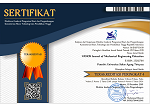THE APPLICATION OF ROTATED PRACTICE METHOD TO IMPROVE PRACTICE LEARNING ACHIEVEMENT IN VOCATIONAL SCHOOL
Abstract
This study aims to determine: (1) the application of rotated practice method in learning the practice of automotive electrical system learning. (2) improvement of student learning achievement after the application of the rotated practice method in learning practices of automotive electrical system learning subjects. The design of this study used a classroom action research design and stopped at cycle two (II). The subject of the study was class XI of light vehicle engineering students class B with a total of 30 students. While the object of research carried out at SMK YPT Purworejo. Data collection used test. The research instrument used practicum questions which consisted of 5 job sheets. The data analysis technique used in this research was descriptive analysis. The results of the study showed that: (1) the method of rotated practice in learning the practice of learning automotive electrical systems can be applied well by students. (2) Student learning achievements in the pre cycle conducted by researchers got the final result 74.14. In the first cycle there was an increase in learning achievement to 76.48 and in the second cycle student learning achievement increased to 84.14 with 100% completeness.
Keywords
Full Text:
PDFReferences
Adnan, A., and Nadia, L. (2015). Teaching In Automotive Practical Task: Practices In Vocational Colleges. Procedia - social and behavioral sciences, 204(1), pp 290-299.
Sudarsono, B.(2018). The Independence And Activeness (Kemanti) – Based Active Learning Strategy To Improve Cooperation And Learning Outcomes. VANOS Journal Of Mechanical Engineering Education, 3(1), pp 23-32.
Christine Serva. (2015)."Rotation Model: Definition, Application & Examples." Study.com. Diambil pada 25 Maret 2020 dari study.com/academy/lesson/rotation-model-definition-application-examples.html
Clarke, L. & Winch, C. (2017). International Approaches, Developments And Systems. New York: Madison Avenue.
Dana Dance-Schissel. (2015). "Online Driver Model: Definition, Application & Examples." Study.com. Diambil pada 25 Maret 2020 dari https://study.com/academy/lesson/online-driver-model-definition-application-examples.html.
Finch & Crunkilton (1999). Curriculum Development in Vocational and. Technical Education. Boston: Allyn and Bacon.
Gessler, Michael. (2017). Areas Of Learning: The Shift Towards Work And Competence Orientation Within The School-Based Vocational Education In The German Dual Apprenticeship System. Technical and Vocational Education and Training, 23(2), pp 695-717.
Hartanto,S., Ratnasari, S., and Arifin,Z. (2019). Work Skills Factor For Mechanical Engineering Students Of Vocational High School. The First International Conference On Education, Science And Training: Empowering Educational Human Resources For Global Competitiveness, Kne Social Sciences, 7(1), pp 1–11.
Leighbody, G.B. & Kidd, D.M. (1968). Methods of Teaching Shop and Technical Subject. New York: Delmar Publisher.
Mursid, R. (2013). Pengembangan Model Pengembangan Praktik Berbasis Kompetensi Berorientasi Produksi. Cakrawala Pendidikan, 32(1), pp 28-38.
Sanjaya, A. (2011). Model-Model Pembelajaran. Jakarta: Bumi Aksara.
Santoso, D. (2017). Begini Mencetak Dokter Profesional. Surabaya : Airlangga University Press.
Tafakur.(2018). Electronic Spark Advance Ignition System Simulator As Instructional Media For Assisting Electrical Practices On Automotive Field. VANOS Journal Of Mechanical Engineering Education, 3(1), pp 43-50.
DOI: http://dx.doi.org/10.30870/vanos.v5i1.7848
Refbacks
- There are currently no refbacks.

This work is licensed under a Creative Commons Attribution 4.0 International License.


.png)
.png)
